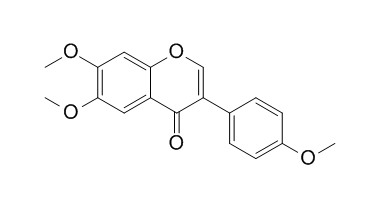4',6,7-Trimethoxyisoflavone
4',6,7-Trimethoxyisoflavone promotes wound healing through NOX2 induction, which leads to collective migration and MMP activation.
Inquire / Order:
manager@chemfaces.com
Technical Inquiries:
service@chemfaces.com
Tel:
+86-27-84237783
Fax:
+86-27-84254680
Address:
1 Building, No. 83, CheCheng Rd., Wuhan Economic and Technological Development Zone, Wuhan, Hubei 430056, PRC
Providing storage is as stated on the product vial and the vial is kept tightly sealed, the product can be stored for up to
24 months(2-8C).
Wherever possible, you should prepare and use solutions on the same day. However, if you need to make up stock solutions in advance, we recommend that you store the solution as aliquots in tightly sealed vials at -20C. Generally, these will be useable for up to two weeks. Before use, and prior to opening the vial we recommend that you allow your product to equilibrate to room temperature for at least 1 hour.
Need more advice on solubility, usage and handling? Please email to: service@chemfaces.com
The packaging of the product may have turned upside down during transportation, resulting in the natural compounds adhering to the neck or cap of the vial. take the vial out of its packaging and gently shake to let the compounds fall to the bottom of the vial. for liquid products, centrifuge at 200-500 RPM to gather the liquid at the bottom of the vial. try to avoid loss or contamination during handling.
Int J Nanomedicine.2024, 19:1683-1697.
Int J Mol Sci.2023, 24(23):17118.
Nutrients.2024, 16(16):2612.
Anticancer Res.2020, 40(10):5529-5538.
Korean J Environ Agric.2018, 37(4):260-267
Biochem Biophys Res Commun.2019, 518(4):732-738
Evid Based Complement Alternat Med.2018, 2018:3610494
Food Analytical Methods2020, 13,1603-1612(2020)
Molecules.2020, 25(15):3353.
Int J Med Sci.2020, 17(5):626-631
Related and Featured Products
Phytomedicine, 2014, 21(4):570-577.
Flavonoids promoting HaCaT migration: II. Molecular mechanism of 4',6,7-trimethoxyisoflavone via NOX2 activation.[Reference:
WebLink]
Flavonoids are major active ingredients in plants and are considered components of food that provide medical or health benefits. They have diversified structures and have effects on human health, including wound healing induction. More than a hundred flavonoids were screened for HaCaT keratinocytes cellular migration measurements and the relationships between their structural properties and the effects promoting cellular migration were examined.
METHODS AND RESULTS:
Here, among flavonoids used in the previous structure-activity relationship calculations, 4',6,7-Trimethoxyisoflavone (TMF) was one of the compounds showing the best activity, so that its molecular mechanism of the wound healing effect on HaCaT keratinocytes was investigated in more detail. Our data revealed that TMF increased the wound healing rate, but not the proliferation rate, in a dose-dependent manner. Treatment of keratinocytes with TMF influenced signaling pathways, affecting the phosphorylation of AKT and ERK in a time-dependent manner. TMF also induced the cell-cell adhesion protein E-cadherin, which is essential for promoting collective cell migration. Furthermore, the TMF treatment group also showed higher ROS and NOX2 transcriptional and protein levels. Correlating with matrix metalloproteinase induction by TMF, levels of extracellular matrix proteins such as collagens I and III were significantly lower in the treatment group. To confirm that the effects of TMF occur through the NOX2 pathway, we co-treated cells with TMF plus an NADPH inhibitor (DPI) or a ROS scavenger (NAC). Western blotting revealed that DPI and NAC attenuated the effect of TMF, suggesting that TMF induces ROS through the NOX2 pathway and regulates keratinocyte migration.
CONCLUSIONS:
In summary, TMF promotes wound healing through NOX2 induction, which leads to collective migration and MMP activation.



